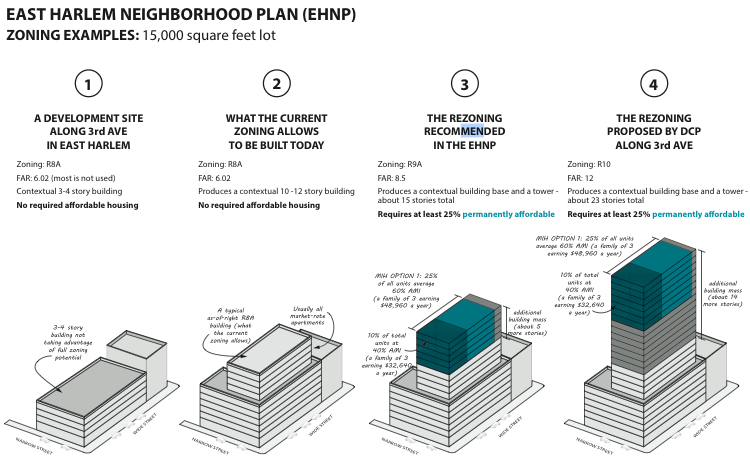
Adi Talwar
Lifelong East Harlem resident Joanne Rodriguez with her niece at the intersection of 116 Street and 3rd Avenue. Both rezoning plans would permit higher buildings on 3rd, but the Speaker's allies say their plan would yield more affordability and less density.
At East Harlem’s community board rezoning task force meeting on Thursday night, George Sarkissian from Speaker Melissa Mark-Viverito’s office offered a case for why the East Harlem Neighborhood Plan’s proposed rezoning makes most sense—more than the city’s own rezoning proposal, or the possibility of not rezoning at all.
The board is currently preparing to take a vote on the city’s plan. While some stakeholders in the neighborhood don’t want any rezoning, others are trying to sway the city to reform its proposal to look more like the rezoning called for in the East Harlem Neighborhood Plan, a strategy created by a steering committee of organizations gathered by Mark-Viverito.
Sarkissian presented three scenarios for a sample property on Third Avenue. Under the current rezoning, that property owner is already allowed to build a 10- to 12-story building, but would not be required to construct any affordable housing.
If the East Harlem Neighborhood Plan’s rezoning were adopted, the building could rise to 15 stories, but the owner would have to comply with the city’s mandatory inclusionary housing requirement, requiring 20 to 30 percent of the housing to be rent-restricted. The vast majority of those extra stories would have to be below-market units.
Under the city’s proposed rezoning, the building could rise to about 23 stories. According to the steering committee’s model, the city’s plan would result in an extra 14 stories, but less than half of those extra stories would be rent-restricted, while most would be market-rate—extra density for density’s sake.

East Harlem Neighborhood Plan Steering Committee
East Harlem rezoning proposals compared
“Do you want this?” said Sarkissian, pointing to the image of what the current zoning allows to be built today, with no rent-restricted units. “Or that?” he said, pointing to the East Harlem Neighborhood Plan model, with new density devoted mostly to rent-restricted units. “The steering committee unanimously decided that we want that.”
The argument holds up for other avenues covered by the plan as well, except for Park Avenue, according to City Limits’ analysis. There, both the city’s rezoning and the East Harlem Neighborhood Plan have proposed introducing mixed-use residential districts to areas currently zoned for manufacturing or auto-use. While the city’s rezoning once again proposes more housing density than the East Harlem Neighborhood Plan, both would introduce market-rate housing to an area where they are now not permitted.
But could just the attention brought by a rezoning exacerbate rising rents in the surrounding community? Sarkissian thought it was a risk, but not a large enough one to dismiss the steering committee’s rezoning.
“It’s hard to kind of correlate how much more interest there is now because there is a rezoning proposed…I don’t think there’s any denying that people are talking about it more because there’s a rezoning proposed,” said Sarkissian, but he and Ahmed Tigani, representing Borough President Gale Brewer, argued that ultimately East Harlem’s real-estate market is already hot whether the city rezones or not, and said the Neighborhood Plan’s proposed rezoning is one of the few ways to ensure the creation of permanent affordable housing.
Some audience members, however, were not convinced that any type of rezoning made sense.
“There’s nothing in these safety nets that will preserve people in this community,” said Jessica Krug, an East Harlem resident and a member of the Freedom and Liberation Organization Harlem, who also expressed concern with the way policing and the criminal justice system contributes to the dislocation of East Harlem residents. “The fact that [the steering committee is] putting this forward like it’s the community is disingenuous, to say the least.”
The evening also featured a presentation by the Department of Housing, Preservation and Development (HPD) on a package of housing initiatives that would accompany the city’s rezoning. In response to both presentations, members of the community board and the audience expressed concern about whether the plan would deter potential displacement, especially of the most low-income residents, in the event of a rezoning.
“Is 20 percent on public sites enough?” asked a staff member from the local homeless advocacy organization Picture the Homeless, referring to the amount of housing for families making below 30 percent AMI ($25,770 for a family of three). The East Harlem Neighborhood Plan proposes setting aside 20 percent of units for such families on all public land, and HPD has committed to doing so on some public sites. “And if not,” she continued, “then what does it look like to do more …. How are we going to offset this inevitable displacement whether we rezone or not?”
Task force members also noted the need for measures to prevent the displacement of commercial businesses and human-service nonprofits (which, as City Limits reported Wednesday, are facing a funding crisis).
They also stressed the need for easy access to legal services for tenants and for measures to make it easier for landlords to work with the city’s affordable housing finance program.
HPD representatives said the city is making new investments in providing legal services for low-income tenants in housing court, and hopes its new Landlords Ambassadors program will improve outreach to landlords.
One of the major challenges facing the board is making sure as many people as possible are informed about the discussion and have a chance to have a say.
“My whole issue is that the communication has to be stronger … community board reaching out to the community verses the other way around,” said Leon Bilgen, a local homeowner who’d shown up because he’d heard incorrect rumors that the city had already approved a rezoning of the lot on his corner. He said he thought many people were not aware of what was going on. “Most of us work everyday and are struggling every day to make ends meet.”
Board member Nilsa Orama had the same concern. “The people that are most affected are not at this table,” she said, referring to those on limited income who are most vulnerable. But she said that the board had been making efforts to improve outreach, but kept getting frustratingly low attendance at task force meetings.
District manager Angel Mescain said he doubted that having meeting on weekends would improve turnout, but that the board plans to “carpet bomb the area” before the crucial community board hearing on the rezoning on Tuesday May 16, which will take place at 6:30 p.m. at the Siberman School of Social Work at Hunter College, 2180 3rd Avenue.
The public is also welcome to attend the board’s Land Use Committee on Wednesday May 10 at 6 p.m. at the Bonifacio Senior Center, 7 E 116th Street, at which city agencies will be present to discuss the rezoning and the redevelopment of the 111th Street ballfields, as well as the next rezoning task force meeting on Thursday May 18, 6 p.m. at the same location.









2 thoughts on “More Than Two Sides to Talk About Potential Rezoning in East Harlem”
This “new plan” is the same old plan only with $48 Billion dollarz of public monies up for grabs by private developers to scam on public land from Mayor DaBlaise’ City Council administration. The affordability criteria are the same as required by the LIHTC provisions since 2000. Who are our politicians trying to scam???
Pingback: News (May 2017)